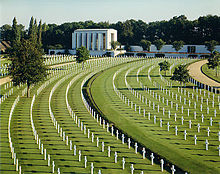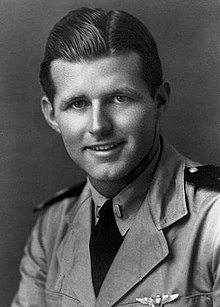Cambridge American Cemetery and Memorial
Cambridge American Cemetery and Memorial is an American war cemetery with a memorial west of the university city of Cambridge in England . A total of 3812 fallen soldiers lie here who lost their lives in France, Italy and North Africa.
History of origin
With the entry of the United States into World War II , large ammunition and equipment depots were set up on English soil. Utilities and military bases followed. The landings in Normandy of June 6, 1944 were controlled from the control and command centers in Great Britain. Nearly two million American soldiers and support forces were previously stationed in the south of England. The Cambridge American Cemetery has an area of 12.5 hectares and is one of the fourteen permanent American war cemeteries built by the American Battle Monuments Commission . It was initially set up as a temporary cemetery in 1943, and the necessary land was donated to the Commission by Cambridge University . After the end of the war, this cemetery was converted into the only American military cemetery on the British Isles as a lasting memory; it was opened and inaugurated on June 16, 1956.
general description
The cemetery was designed and built by architects Perry, Shaw, Hepburn and Dean from Boston, Massachusetts. The landscaping was done by the landscape architects Olmsted Brothers from Brookline (Massachusetts). The main entrance is on the southwest corner of the complex, and here is also the visitor building, on which a bronze plaque is attached, on which the parishes of Chesthunt and Waltham Cross pay homage to the fallen. A large flagpole has been erected on a platform based on the visitor building. From here the visitor has a panoramic view of the entire war cemetery. The water basin adjoining the platform extends as a kind of visual axis to the monument opposite . On the south side of the water basin, the missing soldiers are listed on a large plaque.
The cemetery has the shape of a quarter circle, the west and south sides of which are each framed by trees. To the northeast, the cemetery offers a sweeping view of the surrounding rural landscape. The facility is accessed from the center of the quarter circle. There is a platform with a flagpole.
The memorial
The memorial was built from Portland stones, the following inscription is engraved above the entrance:
"Lord grant you the last rest"
Below the balcony railing is written:
"In gratitude for their sacrifice and in proud memory of their bravery"
The entrance on the west side is delimited by two columns, on the triangle erected above in the roof gable is the following dedication:
"In honor of God and in memory of those who died here for their country 1941–1945"
The main gate to the cenotaph is made of teak, on bronze pictures of war equipment, artillery weapons, armored vehicles, airplanes and ships that were used during the fighting. On the southern outer wall there is a relief depicting the map of Great Britain. In addition, the national coats of arms of the United Kingdom and the United States of America have been arranged and a dedication for the British people has been installed. The locations of the American armed forces were incorporated into the map , and the main directions of attack of the allied armed forces were shown in a location map.
In the interior of the memorial, large situation maps were installed on which the military operations are depicted, above which there are seven boards on which the course of the war in Europe, North Africa and Japan is described. The British and American orders and decorations are shown to the side and above the entrance . The coats of arms of the US states - in the order in which they began -, the national coat of arms of the USA and the coats of arms of the districts of Columbia , Alaska , Hawaii and Puerto Rico were incorporated on the large glass windows .
The chapel
The entrance door to the chapel is made of teak, above the entrance are the words in bronze: "In your hands, Lord", in the choir the two words "Faith" and "Hope". On the front of the altar made of Portland stone there is a bronze cross, to the right and left of the altar is a decorative multi-armed candlestick. The mosaic created by Francis Scott Bradford shows in the center the "Seventh Angel of the Apocalypse" (11.15 EU ), who is surrounded by shadowy planes and mourning angels . The dark blue of the ceiling symbolizes the depth of the sea and infinity, while the lighter colors reflect the light that breaks through the clouds and is intended to herald a new beginning. The following inscription is placed on the ceiling:
- “In the proud and grateful memory of the men of the American Air Force who took their last flight from this friendly island. They did not know the hour of their death and were recalled far from their homeland to follow the heroic aviators who have gone before them. May they rest in peace ”.
The ships grouped around the altar are intended to commemorate the fallen in the navy , the depiction of the Christian cross and the Star of David indicate that people of different religions were buried here. Honor plaques for the missing are attached to a wall made of port stone. The 5126 names recall the missing or drowned in the sea, but also the many unknown victims. An excerpt from President Eisenhower's address of honor is engraved in gold letters above the plaque. Four statues have been erected along the wall of honor; they represent an army soldier, a marine, an aviator and a member of the coast guard.
The tombs
The total of 3,809 tombstones , 24 of them for unknown soldiers, are set up in seven half-arches in the shape of a fan, the paths laid out through the rows of graves symbolically form the spokes of a wheel. Soldiers from the American armed forces and some soldiers from Canada , Chile , Denmark , England , Greece , the Netherlands , Malta , Norway , Panama , Portugal and Scotland rest in the graves . The two most famous names on the missing list are those of Glenn Miller and junior Joseph P. Kennedy .
The horticultural design
The cemetery is built on a hill from which, on a clear day, you can see as far as Cambridge. The complex is framed in the west and south by a tree landscape and forests, to the north it is delimited by the road to Madingley . The water basin on the line of sight is framed by polyantha roses . Double rows of Hagedorn are placed on the honor plaques . On the western side, along the waterway, there is access to the tombs. Wide paths were built between the rows of graves and Japanese pagoda trees were planted between them. A wide gravel path, which is bordered with roses and forsythias , leads to the monument of this complex.
Web links
- Brief description
- The Cambridge American Cemetery and Memorial (English)
- Description of the war cemetery (PDF file; 999 kB)
- Video (English; WMV ; 13.0 MB)
Coordinates: 52 ° 13 ′ 0 ″ N , 0 ° 3 ′ 20 ″ E





